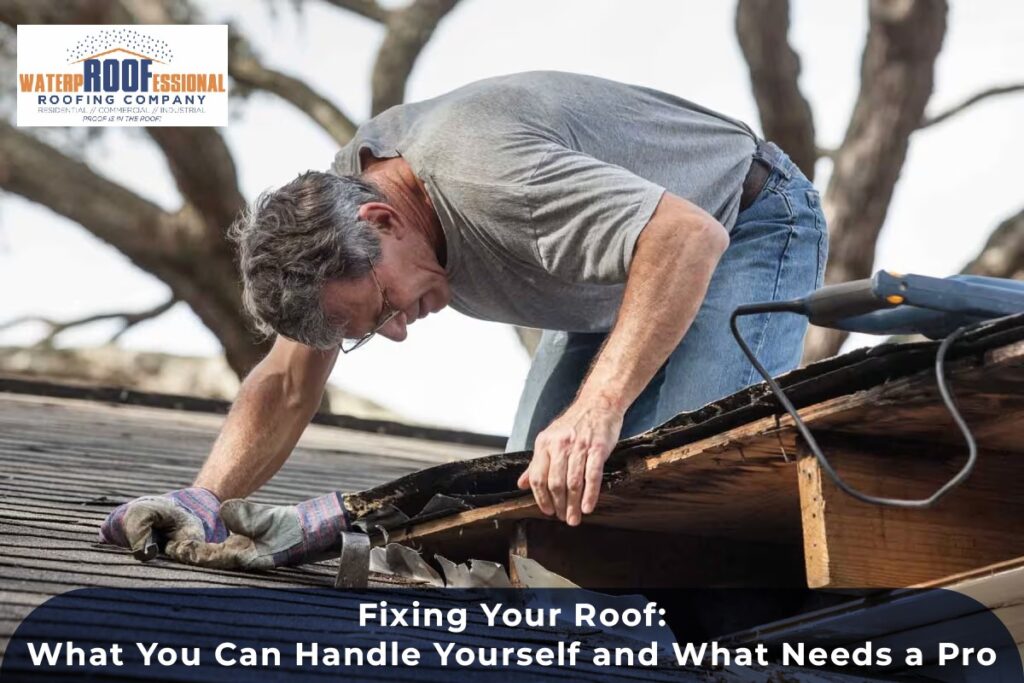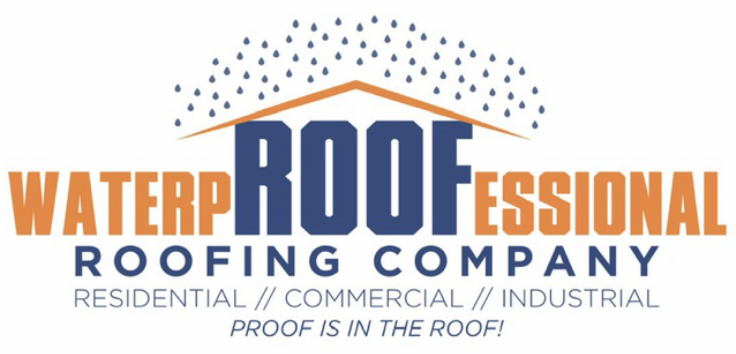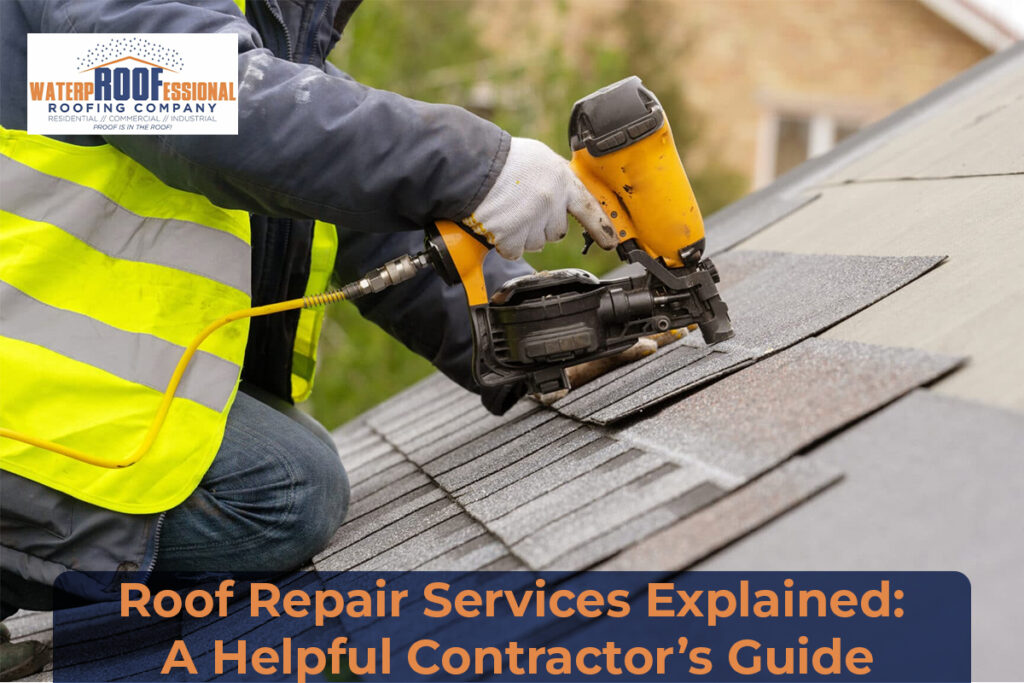Don’t Risk It: Know When to DIY and When to Call a Roofing Pro
Your roof takes a daily beating from wind, rain, snow, and sun, but when it starts to show signs of wear, you may wonder if you can fix it yourself or if it’s time to bring in the experts. The truth? Some minor fixes are doable with the right tools and safety gear, but others are best left to the pros.
In this guide, we’ll break down exactly what you can handle as part of a small roof repair DIY project and which issues call for a professional roofer. We’ll also cover essential safety tips, must-have tools, and common red flags that should stop you in your tracks. Whether you’re patching up a minor leak or tackling missing shingles, we’ve got your back.

What Can You Safely Repair Yourself?
Let’s be honest—the idea of saving hundreds on roof repairs is tempting. If you’re reasonably handy and don’t mind a little ladder work, some DIY projects are perfectly safe and effective.
For example, roof shingle replacement DIY is a common weekend task for homeowners dealing with a few blown-off shingles after a storm. As long as the damage is isolated and the roof decking is still intact, this type of small roof repair DIY is often manageable. Similarly, sealing up minor leaks with roofing cement or replacing worn-out flashing around vents are straightforward tasks for a confident DIYer.
Just be sure to research DIY roof repair tips, follow instructions carefully, and don’t skip the safety steps, because the only thing worse than a roof leak is a fall from the roof.
When It’s Time to Call the Pros
There are times when DIY just doesn’t cut it. If your roof is steep, tall, or badly damaged, call a licensed professional. Attempting a big fix on your own could cost more in the long run—not just financially, but physically.
Problems like sagging rafters, widespread rot, or ongoing moisture problems require more than a surface patch. These are structural issues that need experience and specialized tools to resolve. Professionals have the know-how to fully diagnose and repair major damage while ensuring the integrity of your home.
Want to find reliable experts in your area? Check out the team at Waterproofessional or their trusted roof repair services in Urbana, IL.
Roof Repair Safety Tips You Should Never Ignore
Let’s talk about safety, because even a simple roof job comes with risks. Before grabbing your ladder, review these roof repair safety tips:
- Check the weather. Never work on a wet, icy, or windy roof.
- Use proper footwear. Wear boots with slip-resistant soles.
- Secure your ladder. Make sure it’s on level ground and fully extended.
- Wear a harness. For steeper roofs, always use a roofing harness and anchor point.
- Don’t work alone. Always have someone nearby in case you need help.
Even if you’re only planning some basic roof leak repair DIY, safety should always be your first priority. No fix is worth a fall.
Common DIY Roof Repairs You Can Try
Now, let’s dive into some of the most approachable roof repair tasks homeowners can usually handle themselves.
1. Patching Small Leaks
If you’ve found the source of a small leak, you can usually seal it with roofing cement or a patch. This DIY roof patching is ideal for nail holes, cracked flashing, or minor cracks in shingles.
2. Replacing Shingles
If high winds ripped off a few shingles, don’t panic. Roof shingle replacement DIY just takes a pry bar, hammer, nails, and replacement shingles. It’s a great beginner project for homeowners comfortable with heights.
3. Clearing Debris
Leaves, branches, and other debris can trap water and accelerate roof damage. A good DIY sweep of your roof and gutters can prevent bigger problems later.
For more advice on homeowner-friendly repairs, browse the Roof Repair Services Guide.
DIY Roof Repair Tools You Should Own
Want to be ready for quick fixes? Stock your garage with these roof repair tools for DIY:
- Roofing nails and a hammer
- Pry bar
- Roofing cement or sealant
- Utility knife
- Caulking gun
- Ladder with stabilizer
- Roofing harness (for steeper roofs)
Having the right tools makes any small roof repair DIY task faster, safer, and more effective. You don’t need a full contractor’s arsenal—just the basics will do for minor jobs.
Signs That Mean “Don’t DIY This One”
Some red flags mean it’s time to back off and bring in a professional.
- Multiple leaks or widespread water stains
- Sagging or soft spots in the roof deck
- Rotting wood, mold, or moss growth
- Storm damage that affects a large area
- Structural concerns or bowing beams
If you spot any of these, your roof needs more than a patch. Play it safe and hire a pro.
Final Thoughts: Fix It Smart, Not Just Fast
DIY roof repair can be empowering and cost-effective—but only when done with care, caution, and preparation. Focus on small, manageable fixes like replacing a few shingles or sealing minor leaks. For anything more complex, call in the professionals to ensure your home stays safe and secure.
Need expert help? Trust the pros at Waterproofessional to handle the tough jobs right.
FAQs: Your Roof Repair Questions Answered
Q1: How do I know if my roof leak is serious?
If the leak spreads, returns frequently, or shows signs of mold or rot, it’s serious. Time to call a pro.
Q2: Can I repair a roof in the winter?
It’s possible, but not ideal. Cold weather makes shingles brittle and surfaces slippery.
Q3: What’s the best sealant for DIY roof patching?
Use roofing cement for small cracks and leaks. For flashing or gaps, a high-quality roof sealant works best.
Q4: Is DIY roof repair covered by insurance?
Only if it’s related to storm damage and done properly. Check with your insurance provider first.
Q5: How often should I inspect my roof?
At least twice a year, and after major storms.



